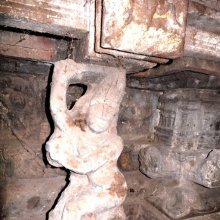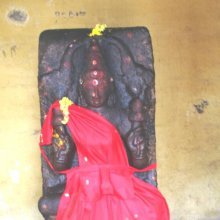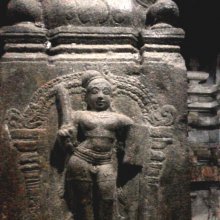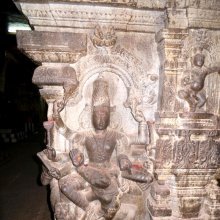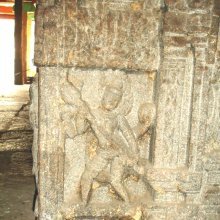Khetaka, Kheṭaka: 26 definitions
Introduction:
Khetaka means something in Hinduism, Sanskrit, Buddhism, Pali, the history of ancient India, Marathi. If you want to know the exact meaning, history, etymology or English translation of this term then check out the descriptions on this page. Add your comment or reference to a book if you want to contribute to this summary article.
Images (photo gallery)
(+3 more images available)
In Hinduism
Shilpashastra (iconography)
Source: Google Books: Elements of Hindu iconographyKheṭaka (shield made of wood or hide) is either circular or quadrangular and has a handle at the back, by which it is held. Sometimes there are curiious emblems and devices depicted on the face of the kheṭaka.
Source: Red Zambala: Hindu Icons and Symbols | IntroductionKheṭaka (shield) - Security, defence, protection of oneself, deflection of negativity and assault by others.
Source: Shodhganga: The significance of the mūla-beras (śilpa)Kheṭaka (खेटक, “shield ”) refers to one of the several “attributes” (āyudha) or “accessories” of a detiy commonly seen depicted in Hindu iconography, defined according to texts dealing with śilpa (arts and crafs), known as śilpaśāstras.—Khaḍga is a sword, long or short, and is used along with a kheṭaka or shield made of wood or hide. The khaḍga is either single-edged or double-edged and has a handle. Kheṭaka is either circular or quadrangular and has a handle at the back, by which it is held. Sometimes there are curious emblems and devices depicted on the face of the kheṭaka.

Shilpashastra (शिल्पशास्त्र, śilpaśāstra) represents the ancient Indian science (shastra) of creative arts (shilpa) such as sculpture, iconography and painting. Closely related to Vastushastra (architecture), they often share the same literature.
Purana and Itihasa (epic history)
Source: Cologne Digital Sanskrit Dictionaries: The Purana IndexKheṭaka (खेटक).—A rural territorial division.*
- * Matsya-purāṇa 283. 3; Vāyu-purāṇa 8. 99, 116; Brahmāṇḍa-purāṇa II. 7. 93 and 111.

The Purana (पुराण, purāṇas) refers to Sanskrit literature preserving ancient India’s vast cultural history, including historical legends, religious ceremonies, various arts and sciences. The eighteen mahapuranas total over 400,000 shlokas (metrical couplets) and date to at least several centuries BCE.
Dhanurveda (science of warfare)
Source: Wisdom Library: DhanurvedaKheṭaka (खेटक) refers to a weapon (“shield”). It is a Sanskrit word defined in the Dhanurveda-saṃhitā, which contains a list of no less than 117 weapons. The Dhanurveda-saṃhitā is said to have been composed by the sage Vasiṣṭha, who in turn transmitted it trough a tradition of sages, which can eventually be traced to Śiva and Brahmā.

Dhanurveda (धनुर्वेद) refers to the “knowledge of warfare” and, as an upaveda, is associated with the Ṛgveda. It contains instructions on warfare, archery and ancient Indian martial arts, dating back to the 2nd-3rd millennium BCE.
Natyashastra (theatrics and dramaturgy)
Source: Wisdom Library: Nāṭya-śāstraKheṭaka (खेटक) refers to a “rider’s shield”, a weapon which should measure should measure thirty aṅgulis in width, according to Nāṭyaśāstra chapter 23. In dramatic plays, weapons such as kheṭaka should be made by experts using proper measurements and given to persons engaged in a fight, angry conflict or siege. It forms a component of āhāryābhinaya (extraneous representation).

Natyashastra (नाट्यशास्त्र, nāṭyaśāstra) refers to both the ancient Indian tradition (shastra) of performing arts, (natya—theatrics, drama, dance, music), as well as the name of a Sanskrit work dealing with these subjects. It also teaches the rules for composing Dramatic plays (nataka), construction and performance of Theater, and Poetic works (kavya).
Chandas (prosody, study of Sanskrit metres)
Source: Journal of the University of Bombay Volume V: Apabhramsa metres (2)Kheṭaka (खेटक) (also Raktā) is the name of a catuṣpadi metre (as popularly employed by the Apabhraṃśa bards), as discussed in books such as the Chandonuśāsana, Kavidarpaṇa, Vṛttajātisamuccaya and Svayambhūchandas.—Kheṭaka has 11 mātrās in each of its four lines (SIS, ISI, S).

Chandas (छन्दस्) refers to Sanskrit prosody and represents one of the six Vedangas (auxiliary disciplines belonging to the study of the Vedas). The science of prosody (chandas-shastra) focusses on the study of the poetic meters such as the commonly known twenty-six metres mentioned by Pingalas.
Kavya (poetry)
Source: OpenEdition books: Vividhatīrthakalpaḥ (Kāvya)Kheṭaka (खेटक) in Sanskrit refers to a “village, hamlet”, as is mentioned in the Vividhatīrthakalpa by Jinaprabhasūri (13th century A.D.): an ancient text devoted to various Jaina holy places (tīrthas).—(CDIAL 3916: Gujarati kheru “small village”, Hindi khera; Sircar 1966 p. 157).

Kavya (काव्य, kavya) refers to Sanskrit poetry, a popular ancient Indian tradition of literature. There have been many Sanskrit poets over the ages, hailing from ancient India and beyond. This topic includes mahakavya, or ‘epic poetry’ and natya, or ‘dramatic poetry’.
Shaktism (Shakta philosophy)
Source: Google Books: ManthanabhairavatantramKheṭaka (खेटक) refers to a “shield” and is used to visualize Bhairava, according to the Manthānabhairavatantra, a vast sprawling work that belongs to a corpus of Tantric texts concerned with the worship of the goddess Kubjikā.—Accordingly, “[...] O Śambhu, he has twenty arms and the goddess sits on his lap. He holds a sword, mallet and noose, a double-headed drum, a dagger, the Kaustubha jewel, a rosary, a skull bowl full of fruit and the like and a piece of human flesh. I will tell you (what he holds) in his other (ten hands). (He holds) an ascetic’s staff, a spear, a book, a shield [i.e., kheṭaka], a head, a large sword, the moon, the scripture and the earth. [...]”.

Shakta (शाक्त, śākta) or Shaktism (śāktism) represents a tradition of Hinduism where the Goddess (Devi) is revered and worshipped. Shakta literature includes a range of scriptures, including various Agamas and Tantras, although its roots may be traced back to the Vedas.
Shaivism (Shaiva philosophy)
Source: SOAS University of London: Protective Rites in the Netra TantraKheṭaka (खेटक) refers to a “shield”, according to the Netratantra of Kṣemarāja: a Śaiva text from the 9th century in which Śiva (Bhairava) teaches Pārvatī topics such as metaphysics, cosmology, and soteriology.—Accordingly, [verse 10.1-7ab, while describing the appearance and worship of Bhairava]—“[...] He] bears a sword and shield (kheṭaka—khaḍgakheṭakadhāriṇaṃ), holds a hook and noose. [His] hand[s and posed] in the wish fulfilling and protection [mudrās. He] holds the thunderbolt of a great hero. [He also] holds an axe and a hatchet. Having worshipped Bhairava, [the Mantrin] remembers being joined in union [with] him, [in the same way as] dissolution in fire”.

Shaiva (शैव, śaiva) or Shaivism (śaivism) represents a tradition of Hinduism worshiping Shiva as the supreme being. Closely related to Shaktism, Shaiva literature includes a range of scriptures, including Tantras, while the root of this tradition may be traced back to the ancient Vedas.
General definition (in Hinduism)
Source: Wisdom Library: HinduismKheṭaka (खेटक) is a Sanskrit word translating to “Shield”.
India history and geography
Source: archive.org: Geography in Ancient Indian inscriptions1) Kheṭaka (खेटक) is a word denoting a ‘village’ or ‘hamlet’ and can be seen as a synonym for grāma, often used in inscriptions.—Terms such as kheṭaka are in many cases, associated with the names of the villages so as to become the ending part of the different place-names. Inscriptions throw light on the location of the villages in different ways. Firstly, they communicate us an idea about the country, the division and the sub-division to which these villages belonged. Secondly, the inscriptions provide information regarding theboundaries of the donated villages.
2) Kheṭaka (खेटक) is mentioned in Alina grant of Dharasena II. It has been identified with Kaira, the headquarters of the Kaira districtia Gujarat. Bhavanagar Plates of Dharasesa III mention the name of the town as Kheṭaka-pradvāra. The name probably means the gates of tbe city of Kheṭaka.
Source: archive.org: Personal and geographical names in the Gupta inscriptionsKheṭaka (खेटक).—Lele considers Kheṭa or Kheṭaka to be the dialectic form of the word ‘kṣetra’. The original meaning of kheṭaka or kheṭa was an enclosure for cattle. In the course of time the pastoral camp grew into an agricultural village, and the word kheṭaka came to include agricultural village.
Source: What is India: Inscriptions of the ŚilāhārasKheṭaka (खेटक) is the name of a village mentioned in the “Janjira plates (set II) of Aparājita”. Kheṭaka mentioned as situated in the Puṇaka viṣaya is the same as modern Kheḍ, about 30 miles north of Poonā.
These copper plates (mentioning Kheṭaka) were found together with those of Set I by one Bala Tukaram, while digging in the court-yard of his house at Chikhala-pākhāḍī, a part of Muruḍ-Janjirā in the Kolābā District of Māhārāṣtra. The grant was made by the king while residing at Sthānaka on the mahāparvan of the solar eclipse which occurred on Sunday, the fifteenth tithi of the dark fortinight of Śrāvaṇa in the expired śaka year 915, the cyclic year being Vijaya.

The history of India traces the identification of countries, villages, towns and other regions of India, as well as mythology, zoology, royal dynasties, rulers, tribes, local festivities and traditions and regional languages. Ancient India enjoyed religious freedom and encourages the path of Dharma, a concept common to Buddhism, Hinduism, and Jainism.
Languages of India and abroad
Pali-English dictionary
Source: BuddhaSasana: Concise Pali-English Dictionarykheṭaka : (nt.) a shield.

Pali is the language of the Tipiṭaka, which is the sacred canon of Theravāda Buddhism and contains much of the Buddha’s speech. Closeley related to Sanskrit, both languages are used interchangeably between religions.
Marathi-English dictionary
Source: DDSA: The Molesworth Marathi and English Dictionarykhēṭaka (खेटक).—n S A shield. Ex. hātīṃ asillatā karīṃ khēṭakēṃ || kaṭiṃ jhaḷakē yamadaṇḍa ||.
Source: DDSA: The Aryabhusan school dictionary, Marathi-Englishkhēṭaka (खेटक).—n A shield.
Marathi is an Indo-European language having over 70 million native speakers people in (predominantly) Maharashtra India. Marathi, like many other Indo-Aryan languages, evolved from early forms of Prakrit, which itself is a subset of Sanskrit, one of the most ancient languages of the world.
Sanskrit dictionary
Source: DDSA: The practical Sanskrit-English dictionaryKheṭaka (खेटक).—
1) A small village, hamlet.
-kaḥ, -kam 1 A shield. ... खड्गखेटकपाणिभिः (khaḍgakheṭakapāṇibhiḥ) Śiva. B.17.42.
2) The club of Balarāma.
Derivable forms: kheṭakaḥ (खेटकः).
Source: Cologne Digital Sanskrit Dictionaries: Shabda-Sagara Sanskrit-English DictionaryKheṭaka (खेटक).—m.
(-kaḥ) 1. A village, the residence of agricultural peasants. 2. A shield. 3. The club of Balarama. E. khiṭ to terrify, &c. ac affix, and kan added.
Source: Cologne Digital Sanskrit Dictionaries: Benfey Sanskrit-English DictionaryKheṭaka (खेटक).—m. A shield, Mahābhārata 4, 181.
Source: Cologne Digital Sanskrit Dictionaries: Monier-Williams Sanskrit-English Dictionary1) Kheṭaka (खेटक):—[from kheṭa] mn. a small village, residence of agricultural peasants, [Viṣṇu-purāṇa; Hemādri’s Caturvarga-cintāmaṇi]
2) [v.s. ...] a shield, [Mahābhārata iv, 181; vi, 799; Varāha-mihira’s Bṛhat-saṃhitā; Hemādri’s Caturvarga-cintāmaṇi] etc.
3) [v.s. ...] n. the club of Bala-rāma (?), [cf. Lexicographers, esp. such as amarasiṃha, halāyudha, hemacandra, etc.]
Source: Cologne Digital Sanskrit Dictionaries: Yates Sanskrit-English DictionaryKheṭaka (खेटक):—(kaḥ) 1. m. A village suburbs; a shield, club of Balarāma.
Source: DDSA: Paia-sadda-mahannavo; a comprehensive Prakrit Hindi dictionary (S)Kheṭaka (खेटक) in the Sanskrit language is related to the Prakrit words: Kheḍaga, Kheḍaya.
[Sanskrit to German]
Sanskrit, also spelled संस्कृतम् (saṃskṛtam), is an ancient language of India commonly seen as the grandmother of the Indo-European language family (even English!). Closely allied with Prakrit and Pali, Sanskrit is more exhaustive in both grammar and terms and has the most extensive collection of literature in the world, greatly surpassing its sister-languages Greek and Latin.
Kannada-English dictionary
Source: Alar: Kannada-English corpusKhēṭaka (ಖೇಟಕ):—[noun] = ಖೇಟ- [kheta-] 1, 2, 3 & 4.
Kannada is a Dravidian language (as opposed to the Indo-European language family) mainly spoken in the southwestern region of India.
See also (Relevant definitions)
Starts with: Khetakadhara, Khetakadharin, Khetakadharini, Khetakamandala, Khetakapura, Khetakarman, Khetakastra.
Ends with: Akhetaka, Khadgakhetaka, Pratikhetaka, Ramakhetaka, Shatkhetaka, Vetrakhetaka.
Full-text (+74): Khedaya, Kheta, Vasunandaka, Khetakapura, Khedem, Khera, Khadga, Pratikhetaka, Sayudha, Khedaga, Shatkhetaka, Akhetaka, Kumara, Ketayam, Kheru, Cetakam, Gramadhana, Rakta, Ahara-vishaya, Aparajita.
Relevant text
Search found 17 books and stories containing Khetaka, Kheṭaka, Khēṭaka; (plurals include: Khetakas, Kheṭakas, Khēṭakas). You can also click to the full overview containing English textual excerpts. Below are direct links for the most relevant articles:
The Linga Purana (by J. L. Shastri)
Chapter 26 - The mode of worshipping Aghora < [Section 2 - Pūrvabhāga]
Chapter 28 - The mode of charitable gifts < [Section 2 - Pūrvabhāga]
Impact of Vedic Culture on Society (by Kaushik Acharya)
Sanskrit Inscriptions (B): The Maitrakas < [Chapter 3]
Chart: Movement of Vedic Brāhmaṇas < [Chapter 3]
Mingling of Cultures (T): The Paramāras < [Chapter 4]
Lakulisha-Pashupata (Philosophy and Practice) (by Geetika Kaw Kher)
Srikantha in the Saiva pantheon < [Chapter 1 - The Historical Context]
Varahi Tantra (English Study) (by Roberta Pamio)
Chapter 29 - The worship of Caṇḍikā < [Summary of the Vārāhī Tantra]
Puranic encyclopaedia (by Vettam Mani)
The Agni Purana (by N. Gangadharan)
Related products
